That's right, a time machine. We're going back to 1850.
When you pull into the parking lot you'll notice a low hill. The Visitor's Center is built into this berm and there's a reason for that. When you step inside you'll find a gift shop with some very nice items. There are museum cases displaying items from the era.
You will notice there's another set of doors toward the back of the gift shop. To the left are the doors to the theater where they present a short film. I'm going to skip that today and exit the back doors into the time machine.
Why is it a time machine? Because once you pass through the berm you will not see anything of modern life. There are no electric wires, road noise or other indications of modern life. Very rarely a jet will pass overhead but otherwise you have entered the land between the lakes in 1850 Kentucky.
A small path winds around to the right and pretty soon the berm is out of sight.
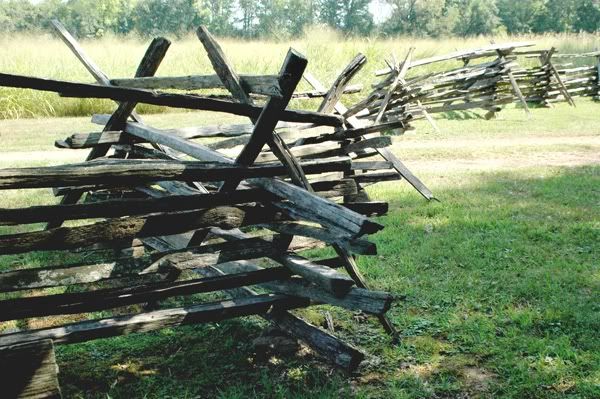
Rail fence along the pathway.
The people who work here live in the 21st century but work in the 19th century. That sounds like the perfect gig for those people who have always felt they were born in the wrong century.
The farm is worked day-to-day, year round (except for the few winter months that they are closed to the public) exactly as it would have been in 1850. The tasks, and what you would see on your visit is dictated by the time of year. In the spring you would see them planting, in the fall, harvesting. You can see the processes of smoking hams and drying tobacco.
Here's a field of tobacco.
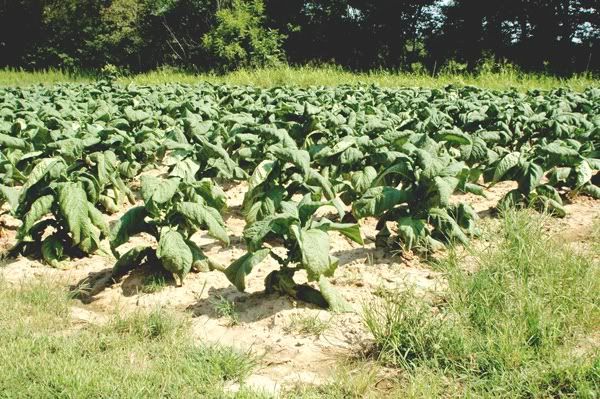
Tobacco growing in the field.
The tobacco is a very familiar sight to me. All my ancestors in Tennessee were tobacco farmers and I remember field after field of these large plants.
This is the gentleman responsible for working the tobacco patch today. It's very hot and he's taking a short break.
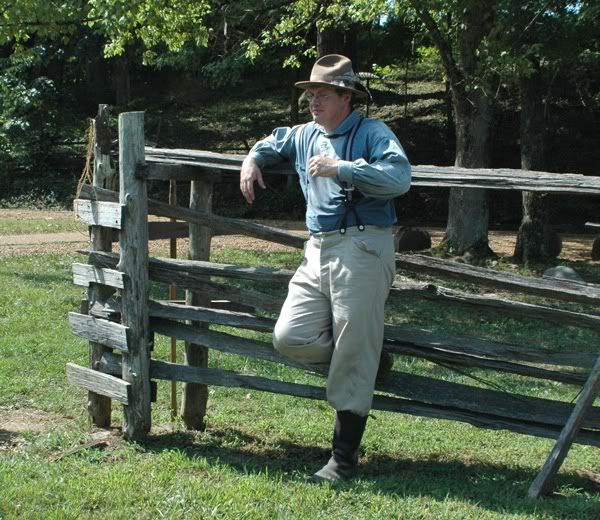
Tobacco farmer.
Next, we're going to visit the large cabin. This is what's called a dogtrot.

Beautiful dogtrot cabin.
This style of dwelling has a hallway down the middle that is open to the outside.
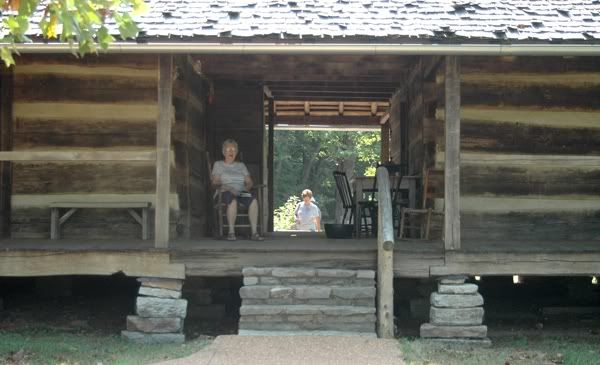
Sitting a spell on the porch.
The rooms are on both sides and this has an upper floor. I've rarely seen a two story dogtrot. The cabin would be raised off the ground to allow air to flow beneath. The chickens and snakes spent lots of time under the cabin also.
And for those of you who think this type of structure is ancient history, think again! My great uncle had a dogtrot house in the rural panhandle of Florida. We visited there many times when I was a kid.
Here's the side of the cabin. That's the kitchen extending out the back. Sometimes the kitchen would be a small separate building, that way if the kitchen caught on fire the entire cabin wouldn't burn down.
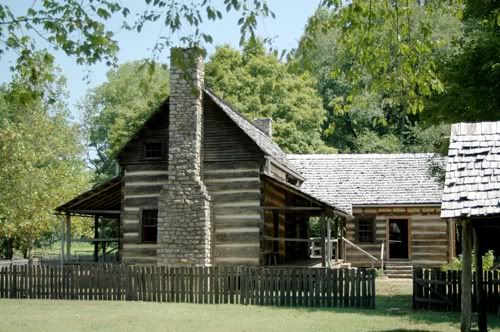
Dogtrot cabin with kitchen.
There's another small open air hallway between the house and the kitchen. This is where the wash pans are set up.
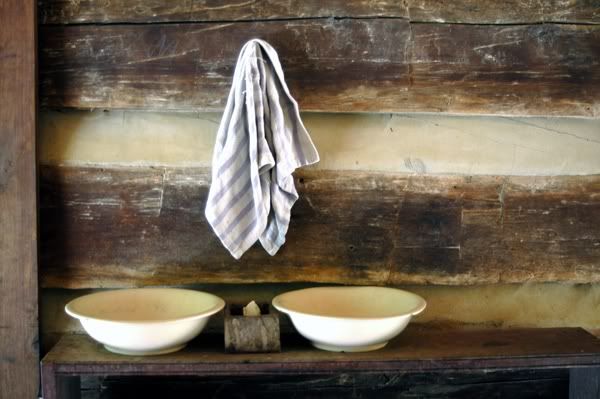
Pans for washing up.
There are potatoes drying on the porch. That rack is lined with a homespun fabric on which the potatoes are dried.

Drying potatoes, 1850 style.
In the kitchen, beans are prepared for cooking.
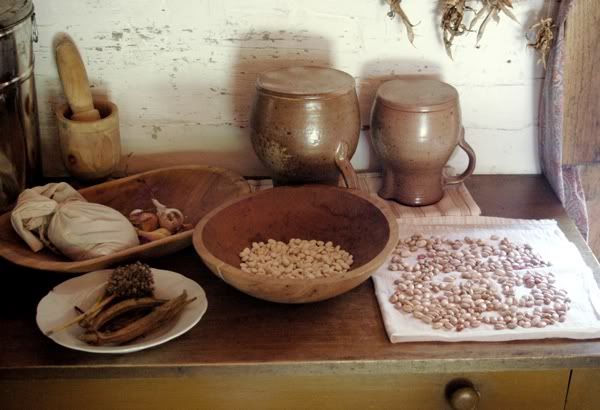
Beans for dinner.
Like the potatoes, beans were dried on a rack.
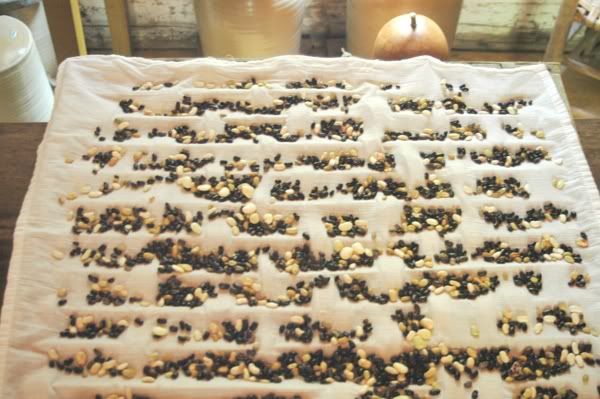
Beans preserved by drying.
There were no written recipes, no thermometers and no timers. It was cooking by the seat of your pants, as I call it. There was no such thing as canning fruits and vegetables in 1850 because the safe Mason-type canning jar and lid hadn't been invented. Women did preserve pickles and sauerkraut in stoneware crocks.
Inside the cabin is a bed with a big featherbed. This looks so inviting, I want to crawl in for a nap after eating the fried chicken and corn fritters that would prepared in the cabin's kitchen.
Here's a recipe for corn fritters.
CORN FRITTERS
2 eggs, separated
4 TBSP. all purpose flour
1 cup fresh corn kernels (or 2 cups canned, drained)
1/2 tsp. sale
freshly ground black pepper
lard for deep frying (or vegetable shortening)
Combine the egg yolks, flour, salt and pepper and corn in a medium sized bowl. In a separate bowl, beat the egg whites until they are stiff, forming peaks. Fold the egg whites into the egg yolk mixture. In a deep iron skillet, melt the lard to a depth of 3 inches and heat until it registers a temperature of 365 degrees on a deep-fry thermometer. Drop the batter by teaspoonfuls into the fat. Frying till golden brown, about 3-4 minutes. Drain well. Serve immediately with honey. Makes about a dozen and a half fritters.
It's going to take more than one day to tour this place so for tonight we're going to rest in this bed with is big, inviting featherbed.

Old fashioned bed with quilt and featherbed.
Come back tomorrow when we'll continue our tour of The Homeplace 1850.











3 comments:
I've got John in here with me looking at the dogtrot. Neither of us had ever heard of this distinctive style home. I wonder how well the open hallway and the "up off the ground" styling helps with cooling. What say you? It's always fun to go on a road trip and, if I can get over my qualms about sleeping in that room...it's not the bed...I'll even spend the night.
This is my kind of trip! Thanks Suzanne. I love history, especially seeing how people used to live, in different places. Here in Canada we get a some good British programming. They had a series called Victorian Farm, with 3 historians living as Victorian farmers, and then they also did a Tudor Christmas feast. There's also one called The Supersizer's Go, with a British couple spending a week in a different time period of British history, following mostly the food of that time period, but some other historical details as well. In Canada a few years ago, we had "Pioneer Quest" following 2 couples living as the pioneers did.
As kids, we took school field trips to Fort Edmonton and there is also a Ukrainian Village. We live too far away now for my kids to take a school field trip, but we really need to take them there some summer. There's also an old abandoned mining town a few hours away that I hear is very interesting too. Far more interesting vacations than sitting on a beach somewhere, I think! :)
This story reminds me of something that happened just yesterday... Our family was "adopted" by an old lady probably 30 years ago who was a friend of the family. We would go over to her house (a brick/plantation type home built in the 1850s) for dinner on most weekends, and oh boy, Christmas time! She loved Christmas decorations! She had millions of lights decorating the inside and outside of her house (her late husband was rich and he used to never allow her to celebrate it). My mom was in charge of decorating her main Christmas tree every year. One time the police department put a car counter in the driver during the holidays and it registered over 1 million cars in 1 month. She died in about 2000, but in her will, she left me money to pay for my college. Anyways, to make a long story short...yesterday morning someone burned the house down completely. I was so upset. Turns out if anyone would've put out the effort it could've been registered as a historical site. Not long ago there was some archaeological digs around there and they determined that indians had lived on her farm since the ice age! The home was even site to the first general store and post office in the area. Makes me sick that no one cared enough to protect it. It just sat there empty. I had no idea it was such a historical house when we would go over there, I just knew it was fun to play in! Here's a link to the article about the fire. http://www.annistonstar.com/pages/full_story/push?article-Davis+farm+burns+down-+arson+suspected+%20&id=9358851&instance=recentComments
Post a Comment